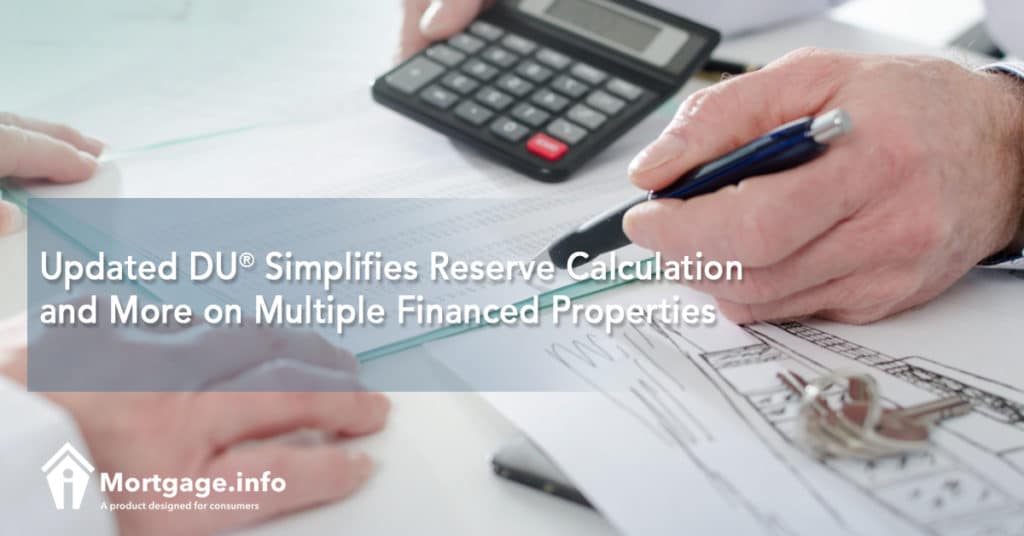Enterprising individuals into buying and selling homes can take advantage of Fannie Mae’s multiple financed properties program. But not all lenders offer this option due to the challenge of underwriting a borrower with existing mortgaged properties of up to 10. There’s also the complex calculation of reserves required for such individual.
Fannie Mae, however, has made enhancements to its guidelines on multiple financed properties for the same borrower. One major improvement is Desktop Underwriter®’s updated messaging that will make it easier for lenders to calculate or verify the required reserves.
Where multiple financed properties are concerned, DU® Version 10.1 makes for easier qualifying among investors with up to 10 financed properties and eliminates the complex reserve calculation that has confused lenders for so long.
With more flexible guidelines offered by Fannie Mae, now’s a good time to consider a conventional loan. [sc_content_link label=”Click here to get matched with a lender.”]
Fannie Mae’s Policy on Multiple Financed Properties, as Updated
The latest DU® Version 10.1 contains updates regarding multiple financed properties. It will issue an updated message containing the specific dollar amount of reserves required for a transaction that received an “Ineligible” recommendation for not meeting the minimum reserve requirement on the subject property and/or other financed properties.
DU® will also contain an updated reserve calculation on other financed properties not associated with the subject property or the borrower’s primary residence.
Eligibility for Borrowers with Multiple Financed Properties
As per the Selling Guide updated as of August 29, 2017, there’s no limit on the number of financed properties a borrower will have or already financed if the mortgage he/she is applying for is secured by his/her primary residence.
If the subject mortgage secures a second or investment home, then the multiple financed properties limit under DU® will apply. The number of financed properties that a borrower is allowed under this policy is 10.
For a borrower with existing 1 to 6 mortgaged properties, standard Fannie Mae eligibility requirements will apply including the minimum credit scores and loan-to-value ratios.
If the same borrower has 7 to 10 financed properties, Fannie Mae requires a minimum credit score of 720. All of its other eligibility requirements will apply.
Minimum Reserves Requirement
Fannie Mae defines reserves as any assets that are readily available or convertible to cash to the borrower after the loan closes.
They usually cover several months’ worth of the subject mortgage’s qualifying payment, PITIA or principal, interest, taxes, insurance and association dues.
Reserves can come from checking and savings accounts, investments, retirement savings accounts, and vested life insurance policies.
[sc_content_link label=”Shop and compare mortgage deals here.”]
The minimum reserves required is dependent on four factors: (1) the transaction type, (2) the subject property’s occupancy and amortization type; (3) the subject property’s number of units; and (4) the borrower’s other mortgaged properties.
Upon determination of the borrower’s total number of financed properties, DU® will use this number to assess the loan’s eligibility including the relevant minimum credit score requirement, and more importantly, the minimum required reserves for the lender to verify.
Additional Reserves Are Required
Notably, owning multiple financed properties means additional reserves to be calculated and documented for such properties.
In calculating the reserves for these other financed properties, the latest DU® will not use the unpaid principal balance of any active mortgage or home equity line of credit on the credit report but not on the loan application.
What the newest DU® will do is to issue a new message listing these credit report mortgages to ensure that lenders will come up with an accurate calculation of the minimum reserves required for the other financed properties.
Overall, the borrower must hold sufficient assets to close the transaction, after meeting the minimum reserve requirements, and additional reserves for that matter. One is allowed, however, to supplement funds to meet his/her reserve requirements from acceptable sources.
The changes embodied in DU® Version 10.1 create more flexibility for individuals making the most of the housing market and lenders reaching to this demographic of savvy homebuyers.
[sc_content_link]

